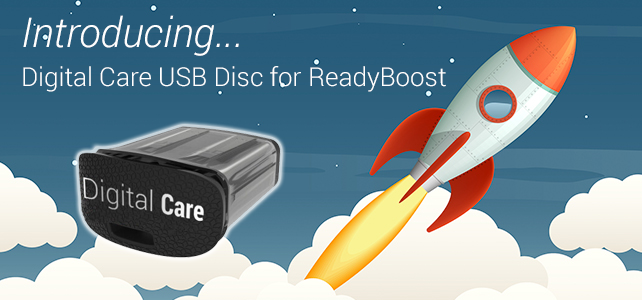
Q: What is ReadyBoost and how does it help my PC speed?
A: ReadyBoost is a Microsoft Windows technology that allows you to use ReadyBoost compatible USB flash drive, such as Digital Care ReadyBoost USB Disc, as an additional memory. Doing so, ReadyBoost improves your system’s performance by providing quicker access to data compared to accessing the information from the hard drive. To learn more about the ReadyBoost technology, please read this blog post.
Q: What’s the System Requirement for Digital Care ReadyBoost USB Disc?
A: Digital Care ReadyBoost USB Disc supports Windows Vista, Windows 7, Windows 8/8.1, and Windows 10
Q: Do all USB flash drives support the ReadyBoost technology?
A: No. A USB flash drive must meet the minimum random ready and write speeds requirements to support the ReadyBoost feature. In order for ReadyBoost to work, it requires a USB storage device to have at least: 64MB, USB 2.0, read at 3.5 MB/s, and write at 2.5 MB/s. Our Digital Care ReadyBoost USB Disc well exceeds this requirements.
Q: Aren’t Hard Disks faster than flash? My HDD has 80MB/sec throughput.
A: Hard drives are great for large sequential I/O. For those situations, ReadyBoost gets out of the way. We concentrate on improving the performance of small, random I/Os, like paging to and from disk.
Q: What’s the recommended capacity for a USB flash drive for ReadyBoost?
A: We recommend a 1:1 ratio of flash to system memory at the low end and as high as 3:1 flash to system memory. So if your existing PC has a 4 GB of RAM, then you should choose a 4 GB USB flash drive for ReadyBoost, or consider an 8 GB or 12 GB USB flash drive if possible.
Q: I encounter the message: “This device cannot be used for ReadyBoost – The device does not have the required performance characteristics for use in speeding up your system”. What should I do?
A: Your Digital Care ReadyBoost USB Disc is fully compatible for Microsoft ReadyBoost technology. When you encounter this message, you simply need to format your USB flash drive.
To do so, open Windows | File Explorer (or use keyboard shortcut: Windows Key + E), right-click the newly discovered removable drive and select Format…
In File system dropdown menu, choose NTFS. In Allocation unit size, choose Default allocation size. And check Quick Format under Format options. Click Start.
Once the formatting is completed, your Digital Care ReadyBoost USB Disc is ready to be used.
Q: What does it mean if Windows states that “ReadyBoost is not enabled because this computer is fast enough that ReadyBoost is unlikely to provide additional benefit“?
A: This probably means that your Windows operating systems is installed on an SSD and no performance gain is possible. This is only true in theory because each PC is different. If you feel that your PC is sluggish and requires optimization, please contact our support team (support@CompuClever.com) for further options of how to speed up your PC.
Q: What happens when you remove the drive?
A: When a surprise remove event occurs and we can’t find the drive, Windows fall back to disk. Again, all pages on the device are backed by a page on disk. No exceptions. This isn’t a separate page file store, but rather a cache to speed up access to frequently used data. So no data loss will occur.
Q: Won’t ReadyBoost wear out the drive?
A: Nope. ReadyBoost technology is designed to take care of the lifecycle issues with flash drives and are smart about how and when it performs writes to the device. Relevant third party tests show that you will get at least 10+ years out of flash devices by using the ReadyBoost technology.
Q: How secure is ReadyBoost?
A: ReadyBoost is secure. ReadyBoost by default uses Advanced Encryption Standard 128 (AES-128) encryption, which should be sufficient as the chances of exposing sensitive data are very slim.
Q: What alternatives are there to ReadyBoost?
A: Two alternatives that will significantly improve performance over ReadyBoost are:
- Using a Solid State Drive (SSD) for your Operating System drive.
- Adding additional memory (RAM) to your computer.
Nevertheless, neither alternatives are cheap or easy to perform, as compared to using the ReadyBoost option.
